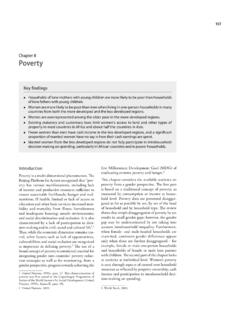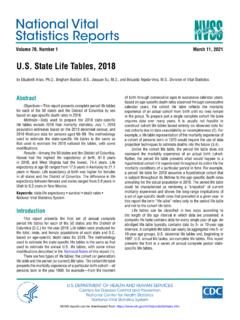Transcription of Direct and indirect impact of the vaccination programme on ...
1 Direct and indirect impact of the vaccination programme on COVID-19 infections and mortalityDirect and indirect impact of the vaccination programme on COVID-19 infection and mortality 2 Contents Background .. 3 Methods and results .. 3 Acknowledgements .. 5 References .. 5 Direct and indirect impact of the vaccination programme on COVID-19 infection and mortality 3 Background Four coronavirus (COVID-19) vaccines have now been approved for use in the UK. Rigorous clinical trials have been undertaken to understand the immune response, safety profile and efficacy of these vaccines as part of the regulatory process. Ongoing monitoring of the vaccines as they are rolled out in the population is important to continually ensure that clinical and public health guidance on the vaccination programme is built upon the best available evidence.
2 PHE publish weekly reports looking at vaccine effectiveness and the impact of vaccination on the population (1). Here we examine the Direct and indirect impact of the vaccination programme on COVID-19 infections and mortality . Methods and results The PHE/Cambridge real-time model has been used to track the COVID-19 infection throughout the pandemic, providing key epidemic insights, including estimation of the reproduction number, R, to the Scientific Pandemic Influenza subgroup on Modelling (SPI-M) and to the Scientific Advisory Group on Emergencies (SAGE). The application to data from the first wave has been published in Real-time nowcasting and forecasting of COVID-19 dynamics in England: the first wave (2). Since the first wave, the model has been constantly improved to capture the pandemic activity as it develops, in particular to account for the impacts, both Direct and indirect , of the vaccination programme .
3 The Direct impact of vaccination is the number of deaths saved in those that get infected, whereas the indirect effect incorporates the additional prevention of infections. The history of real-time modelling outputs can be found at Nowcasting and Forecasting of the COVID-19 Pandemic (3), with the most recent results on which the figures here are based is currently available at COVID-19: nowcast and forecast (4). vaccination rates in the model are based on the actual number of doses administered, and the vaccine is assumed to reduce susceptibility to COVID-19 as well as mortality once infected. Estimates for vaccine efficacy are based on the best available published results (5). To infer the impact of vaccination , the model was fitted to both ONS prevalence and daily COVID- 19 mortality data in England, resulting in posterior samples for a range of epidemiological parameters.
4 The posterior samples were then used to simulate the number of infections and deaths that would have occurred without vaccination (Figure 1). Finally, the total impact was calculated by comparing the infection and mortality estimates with vaccination versus the simulated outcomes without vaccination (Figure 2; Table 1). The figures in Table 1 are expected to continue to grow rapidly as the number of deaths in the no- vaccination scenario is still showing exponential growth. The no- vaccination scenario assumes that no other interventions are implemented to reduce incidence and mortality . Therefore, the findings presented here should be interpreted as the Direct and indirect impact of the vaccination programme on COVID-19 infection and mortality 4 impact of the vaccination programme on infection and mortality assuming no additional non-pharmaceutical interventions were implemented.
5 In practice it is impossible to predict what interventions would have been implemented in the absence of vaccination , although it is reasonable to assume that lockdown measures would have remained in place for substantially longer. Figure 1. Inferred and predicted incidence, mortality and prevalence with and without vaccination in England Figure 2. Averted number of infections (left) and deaths (right) due to vaccination (cumulatively) Direct and indirect impact of the vaccination programme on COVID-19 infection and mortality 5 Table 1. Inferred reduction in infections and mortality as the result of vaccination up to 19 June 2021. (Infections are rounded to the nearest 1,000, deaths to the nearest 100.) Model Outcome Reduction ONS/Death Infection 7151000 [ 6396000 , 7887000] ONS/Death mortality 27200 [ 26100 , 28400 ] Acknowledgements The work presented in this report is joint work completed by PHE and Cambridge University s MRC Biostatistics Unit.
6 References 1. Public Health England. COVID-19 vaccine surveillance reports 2. Birrell Paul, Blake Joshua, van Leeuwen Edwin, Gent Nick and De Angelis Daniela (2021). Real-time nowcasting and forecasting of COVID-19 dynamics in England: the first wave Philosophical Transactions of the Royal Society B 376: 20200279 3. MRC Biostatistics Unit. Nowcasting and Forecasting of the COVID-19 Pandemic 4. Birrell, Paul, Joshua Blake, Edwin van Leeuwen, MRC Biostatistics Unit COVID-19 Working Group, Daniela De Angelis (2021) COVID-19: nowcast and forecast . Published 25 June 2021 5. Public Health England (2021). COVID-19 vaccine surveillance report, Week 24 6 Published: 28 June 2021 PHE gateway number: GOV-8775 Website: Twitter: @PHE_uk Facebook: Crown copyright 2021













